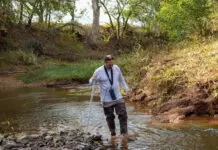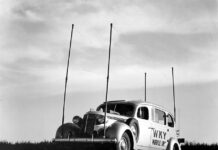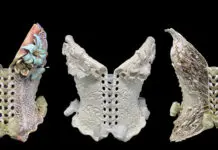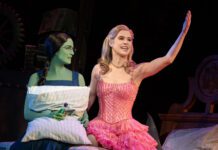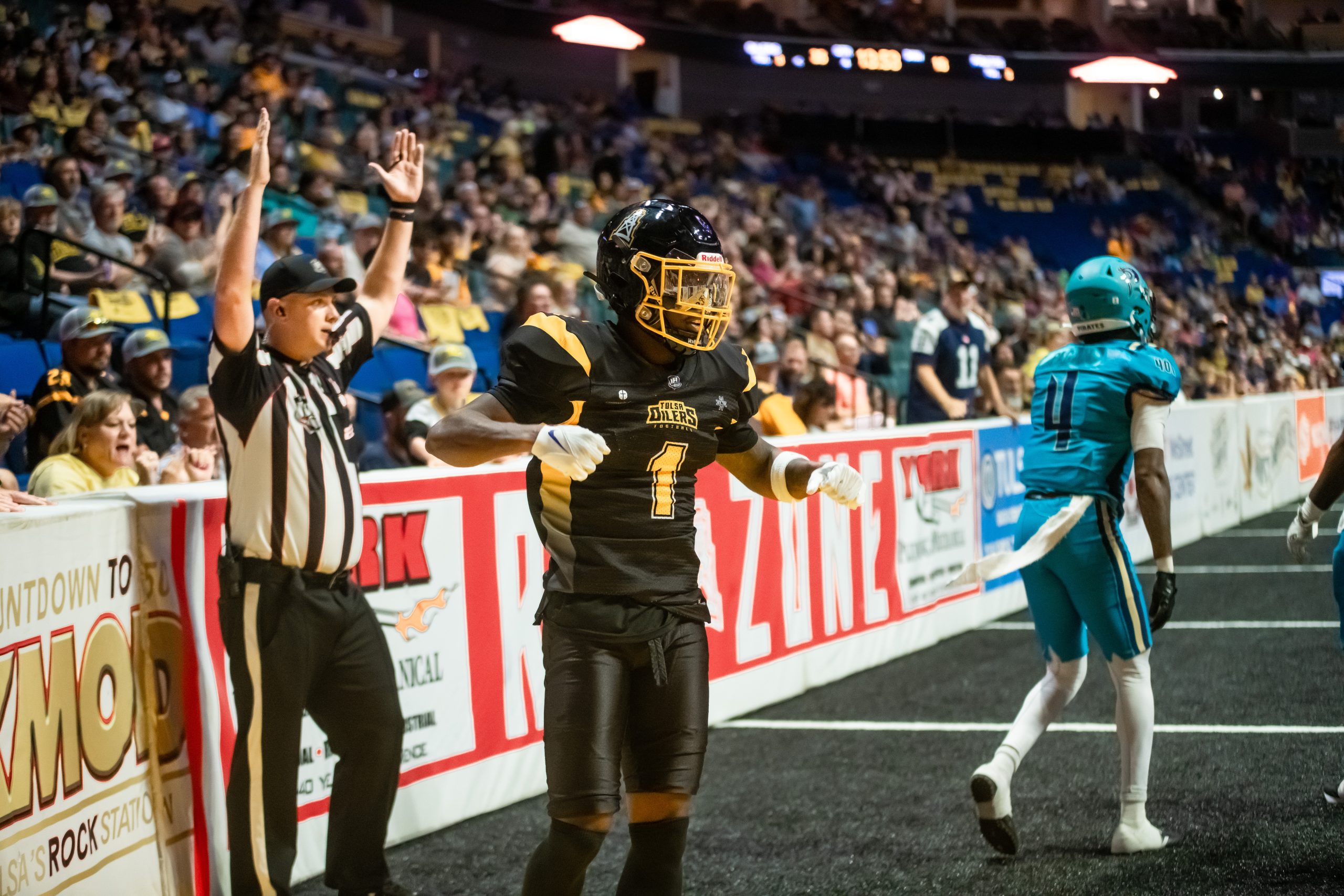The Los Angeles boys of Cold War Kids return to Oklahoma for a night of raw melodies and heart-pumping drumbeats. The band first appeared in 2006 with the breakthrough LP Robbers & Cowards, fronted with the popular songs “Hair Down” and “Hang Me Out to Dry.” After two more albums, the world was forced to wait two years for another studio release from the indie rock quartet. Armed with a new guitarist and deeper stories to tell, the April 2013 release of Dear Miss Lonelyhearts gave fans ten tracks of fresh music evolved from their signature and well-known sound. Cold War Kids make a stop on their North American tour at Cain’s Ballroom, 423 N. Main St., in Tulsa on Wednesday, Aug. 21. The show is scheduled for 8 p.m. with doors opening at 7 p.m. Tickets are $19-$35 each, available at the Cain’s Ballroom box office or online at www.cainsballroom.com.
Special Report: Education
The Digital Classroom
As more higher education programs move online, classroom doors are opening for students of all stripes.
Global Leaders
Oklahoma schools look to the future to create some of the most innovative programs on the planet.
The Master Plan
Demystify the college search process.
Scoring Success
Standardized testing in Oklahoma schools is always evolving.
Private Matters
Choosing the correct private school for your child is vital in achieving the best education.
Going Places
If these 2013 graduates from Oklahoma high schools are any indication, the state’s future will be very bright.
More Than A Game
In the lyrics to the song, “The Lower 48,” by alternative country band The Gourds, singer Kevin Russell assigns brief, one or two sentence descriptions to each of the 48 contiguous states. When he comes to Oklahoma, he sings “Oklahoma is a dirty red mean/Native American slot machine.” As with most songs by the band, Russell sings the lyrics with a twinkle in his eye and his tongue planted in his cheek. But the line also reflects a wider perception of Oklahoma, that of a state that is heavily populated by American Indians and whose economy is primarily fueled by casinos.
Data from the 2010 U.S. Census shows 321,687 Oklahomans identified as Native American, or about nine percent of the state’s total population, good for third among the state’s racial groups, after white and Hispanic/Latino. Not bad, but not exactly as the song would suggest. As for casinos, they are definitely becoming a more common sight across the state, and they are an increasingly vital component to the state’s economy. But they are only one part of the growing network of Native American tribal businesses that are helping to make Oklahoma’s economy one of the healthiest in the nation.
Diverse Interests
“We’re much more than just a gaming tribe,” says Judy Allen, public relations director for the Choctaw Nation. “We’ve got a tremendous focus right now on culture and heritage job development and diverse markets. For instance, one of the things that we’re doing is a large print business here in the Choctaw Nation. We were named one of the top 400 printing businesses this year with Texoma Print Services.”
The idea of expanding beyond established economic opportunities has become a routine practice among Oklahoma tribes. It’s a practice that is benefitting the individual tribes and their surrounding communities, as each business entity creates jobs for Oklahomans.
“One of the things we’re doing is looking really hard in the areas of government contracting, especially with 8A,” says Creek Nation Chief George Tiger, referring to the federal business development program. “We haven’t been as aggressive as we should be. And we’re certainly going to be doing that because I believe we’ve missed out for too long. 8A is something that a number of tribes are getting involved with.”
Oklahoma Native American tribes are diversifying. Health care has always been a major focus of tribal economies, but tribes are now expanding into telecommunications, manufacturing and production, aerospace and oil and gas services. Any industry that gives a tribe a chance to grow economically is a target. Even sweets.
“We have a chocolate, confectionary business that decorates chocolates. We just built a new plant, relocating from our site near Pauls Valley to a brand new plant at the intersection of I-35 and State Highway 7,” says Neal McCaleb, Chickasaw Nation Ambassador at Large and Chairman of the Board of Chickasaw Nation Industries. “The tribe has other economic enterprises besides gaming, like our bank, which has been very successful. We’re the second largest lender through the FHA 184, which is a special FHA program for Native Americans. We are second only to Wells Fargo, which is a huge bank, and ours is just a little community bank.”
“In our other businesses (besides gaming) we had a 60 percent increase last year,” says Cherokee Chief Bill John Baker. “We are diversifying, we are doing a better job at our outside businesses. We averaged over a million dollars a day in our 8A businesses and outside contracts last year alone.”
Major Impact
In October 2012, Oklahoma City University’s Steven C. Agee Economic Research and Policy Institute published The Statewide Impacts of Oklahoma Tribes. According to the study, the 38 federally recognized Native American tribes in Oklahoma combined to generate $10.8 billion to the state’s economy, or roughly seven percent of the state’s $148 billion in economic production. Tribal entities employ more than 50,000 Oklahomans, both tribal members and non-members, with payroll figures in excess of $1.5 billion. These figures represent tribal entities, but not privately owned Native American businesses, such as TERO contractors, who are largely Native American owned and who largely employ Native American workers.
“We’ve got a new housing program that we’re literally trying to build 100 percent with Cherokee contractors, Cherokee materials, Cherokee everything,” says Baker. “And it’s going to have a huge economic impact that is really outside of the government.”
“We don’t count those TERO dollars in our economic impact, but clearly that’s Native American in a ripple effect,” adds Amanda Clinton, Cherokee Nation communications director.
Gaming Pays Off
Still, in the end, the largest economic impact remains the gaming industry, which includes the casinos, casino hotels and resorts. According to the Steven C. Agee report, gaming generates an estimated $4.8 billion in revenue, more than six times that of all other tribal industries combined.
“We’re taking the next $100 million from gaming, and we’re going to build a new hospital, add on to two clinics and build two brand new clinics that won’t be financed, and there will be no payback on,” Baker says. “And we can make health care in the Cherokee Nation world class by making this $100 million investment.”
Across the state, Native American-owned casinos have emerged as leading destinations for visitors from around the country. Major gaming facilities include the Cherokee Nation’s Hard Rock Hotel and Casino in Catoosa, Winstar World Casino in Thackerville and Riverwind Casino in Norman operated by the Chickasaw Nation, the Muscogee (Creek) Nation’s River Spirit Casino in Tulsa, Downstream Casino & Resort operated by the Quapaw Tribe, the Citizen Potawatomi Nation’s Grand Casino in Shawnee and the Osage Nation’s Osage Casinos. And there are dozens of smaller gaming facilties throughout the state.
As gaming has become the most vital fuel in the economic growth of Oklahoma’s Native American tribes, the tribes themselves have become experts in the gaming industry.
“The Cherokees, we’ve always tried to be top of the market,” says Baker. “We’ve tried to be in front of everybody else. We always try to have the absolute best entertainment experience. We try to have the best hotel rooms. If folks are going to come, and it’s going to say Cherokee, then we want it to be the absolute top of the market.”
That quest for excellence drove the Cherokees to adopt the Hard Rock brand in 2009 along with a host of upgrades to the Catoosa location. Other tribal governments are also doing their homework and strategically expanding gaming operations in ways that make the most economic sense and serve to expand, rather than saturate the gaming market.
Muscogee (Creek) Nation Casinos recently announced a $250 million dollar deal with Margaritaville to bring that brand to its Arkansas River property in Tulsa. The project will dramatically transform the area with a new casino and 22-story, 500 room hotel and a theater and event center among other amenities.
Osage Casinos, which contributed a record $38 million to the tribe in 2012, has adopted a plan to expand all seven of its casinos, spending around $9 million on each facility over the next several years. The flagship Tulsa location has received upgrades, while the Sand Springs facility got a major makeover, including a new bar and dance floor and sit-down restaurant. Construction is under way in Skiatook and Ponca City to dramatically reinvent those properties with expanded casinos, and full-service hotels.
The Quapaw Tribe recently completed expansions to Downstream Casino, which straddles the Oklahoma, Missouri and Kansas borders and draws customers from a broad geographical region. The Kappa Tower expansion added 152 rooms, including 16 luxury suites to the casino’s inventory, along with a new spa and indoor swimming pool.
Just north of the Oklahoma-Texas border, the Chickasaw Nation is rapidly expanding what is already the world’s third largest casino, continuing to play on the luxury global travel theme that has already served it well. The Winstar World Casino unveiled a new entry, Paris-themed casino and several new amenities late last year, and construction of an additional, 18-story, 500-room hotel is in the final stages.
The Citizen Potawatomi Nation has also upgraded its major casino property just outside of Oklahoma City in Shawnee. The tribe rebranded the facility as the Grand Casino Resort last year and opened the full-service, 262-room Grand Hotel in July. Construction is also underway on new dining options, a pool and lounge and a 2,500-seat event center.
These are only a few examples from some of the larger facilities around the state. There have also been significant additions at smaller casinos and gaming centers in every corner of Oklahoma. The growth of gaming and the bullish expansion in a broad spectrum of industries point to a bright outlook for Oklahoma’s native tribes and likely a growing share of the state’s economic output.
Equality Advocate
After a successful career in the advertising and nonprofit sectors in New York City, Scott J. Hamilton moved to Oklahoma to become executive director of Cimarron Alliance, an Oklahoma City-based organization that works to educate and advance equality for lesbian, gay, bisexual and transgender Oklahomans. In March, the organization opened the Cimarron Alliance Equality Center, an education center and meeting place for LGBT Oklahomans.
Cimarron Alliance has been around for almost 20 years. It began as a political action committee and moved into a nonprofit organization about four or five years after its founding. One of the big challenges for Cimarron over the years was that people knew it was a PAC and assumed it was expensive to be a part; there was a perception that Cimarron was an organization for rich, white, gay men. The work shifted, but the perception remained a difficult one to change. In December 2009 I left New York and came to Oklahoma to do work (as executive director) in what has proven to be at times a very volatile political landscape, but the work is very rewarding. In the three years I’ve been here, we as a community have moved the ball down the court and have educated about the needs of the community and introduced a sense of normalcy about who the LGBT community is.
I’d been here about a year when talks began about opening an equality center. We prepared a way to do that, then looked at 2014 as a target opening year. Things happened at the end of 2012 that forced our hand, and we had to move with greater speed than we had planned. We raised our flag and opened our doors to the Cimarron Alliance Equality Center in March. In the short time since we’ve opened our doors, the number of people coming in with ideas for services and programming has been truly astounding. One of the defining goals of creating the space was to provide a space where people can come and talk about issues affecting their lives.
Nationally, we are in the midst of more rapid change than has ever existed for the LGBT community. In the last few months, three states and two countries have legalized marriage equality. Many of us would not have thought there would be that much forward movement in such a short amount of time. What we’re seeing in Oklahoma is a ramping up of anti-gay rhetoric and physical attacks on people because of their sexual orientation. When the majority feels like they’re losing their grip, these are the things that happen: rhetoric and violence. This is what happened when women were closer to gaining the right to vote and with the Civil Rights Movement. It’s what happens when the majority feels like things are not like they have always been.
In 20 years I hope there’s no longer a need for someone to be in my job. I hope there is great enough acceptance and assimilation of gay people into the fabric of life in Oklahoma that there may simply not be a need for an organization like ours in its present form. However, it’s going to take a lot of work and be a challenging road to get to that place. We have so many folks in Oklahoma that are ignorant about gay people in Oklahoma. There is a lot of fear, and in some ways the church affords people license to beat up, figuratively, on gay people, and some of that goes to a physical side. While we make progress, we’ll continue to be vigilant in advocacy and activism but also on the education side.
Ed. Note: This interview was conducted prior to the Supreme Court’s ruling on the Defense of Marriage Act. For reaction to the decision by Hamilton and others, visit www.okmag.com.
Simply Healthy: It’s in the Bag
School bells will soon be ringing again, changing parents’ thoughts from what the kids do all day to what they will eat for lunch. While fewer kids are taking their lunches to school, there are definite advantages to it
By packing a lunch, you can better control what your child is eating and the cost. Coming up with creative lunches may be quite a challenge though, especially if you have a picky eater.
Also, since most schools only allow a short time to eat, children need foods that are appealing, filling and easy to handle.
One key to getting kids to eat their lunch instead of trashing it is to involve them in the process. If it seems there’s no time to do that, make time. It’s a fact that kids are more likely to eat what they help prepare. Talking to them about their preferences and providing healthy options can make them feel involved and more likely to actually eat and enjoy their lunch.
Make lunch interesting by presenting their favorite foods in a new way. For example, instead of sending an ordinary peanut butter and jelly sandwich, wrap it up in a tortilla and then slice to make pinwheels. Another idea is to make quesadillas or even crepes with favorite fillings.
One last tip is that kids eat with their eyes first, just like adults. If food is colorful and attractive, they are much more likely to give it a try.
DIY Pasta Salad
Makes 4-6 servings
1 lb. pasta, cooked and drained
2 c. diced meat
2 c. diced cheese
2 c. diced veggies
1 c. low-fat salad dressing (Italian, Ranch, etc.) or more, if needed
Salt and pepper to taste
Fresh or dried herbs (optional)
In a large bowl, combine all ingredients; toss to coat everything well.
Faves: Villa Ravenna
The dining room is cool and pleasant, its wood-paneled walls a soft, aquatic green reminiscent of the sea that washes the shores of the owners’ home town of Ravenna, Italy. Look toward the ceiling and you’ll see a row of splashy exotic glass vases hand-blown in Murano, small islands near Venice. Each is one of a kind, the product of many hours of painstaking labor, made by skilled artisans using techniques handed down from generation to generation. Every dish served at Villa Ravenna is like that, too. “My grandparents owned a restaurant near Ravenna,” says Sergio Orioli, “and so we have been in business for three generations. We do the same thing the same way as many years ago.” The food here is not Italian-American, but Italian. The Fettucine al Nero di Seppia could be served in a beachside trattoria in Ravenna’s sun-kissed marina. Homemade pasta made with squid ink imported from Spain accents a vibrant mix of seafood and spice. For the less adventurous, the menu offers zesty versions of familiar dishes found throughout Italy: chicken cacciatore, spaghetti carbonara. But Villa Ravenna also, Orioli says with pride, “has items no one else in Oklahoma has.” These aren’t on the menu. They are seasonal. Fresh figs topped with gorgonzola and prosciutto. Irresistibly tender osso buco made from wild boar. Aged venison filet in Grand Marnier sauce. Enormous grilled shrimp, each one half a pound. 6526 A E. 51st St., Tulsa. www.villaravenna.com
Keeping A Legacy
Osiyo.
Ha’-We.
Chokma.
Of the 38 federally recognized tribes in Oklahoma, these are three – Cherokee, Osage, Chickasaw – of their indigenous greetings. To ensure future generations won’t ever have to say goodbye to their history, culture and language, many tribes have launched meticulous preservation efforts.
These efforts include teaching, archaeology, archiving, renovation – and a lot of persistence. Currently, 566 federally recognized tribes exist in the United States, though full-blooded Native Americans (and Alaska Natives) compose only 1.2 percent of the population, per 2012 Census Bureau estimates. In the wake of conventional American society, instructing new generations about their distinctive heritage and culture is more important than ever.
Text me in Cherokee
The Cherokee Nation, spread out like a blanket among 14 counties in northeast Oklahoma, comprises the largest tribe in the U.S.
Cherokee is a word that has been spelled many ways and has been infused with many possible meanings and origins. Currently, Cherokees call themselves Aniyvwiya, which translates to the “Real People.”
These Native Americans never lived in teepees; instead, Cherokee dwellings were historically houses created of mud and clay with roofs of brush and river cane. By the 1700s, many Cherokees lived in log cabins and even clapboard houses.
In the early 1800s, Cherokee statesman Sequoyah developed the first written language of any Native American tribe. The Cherokees “come from a rich tradition of innovators,” says Principal Chief Bill John Baker.
“We published a newspaper, written in both Cherokee and English,” Baker says. “We created a legislature and a strong sense of self-governance that persists today.”
To protect the Cherokee language, the tribe has kept pace with new technology. “We have worked with Apple to incorporate our language into the operating systems for Macs, iPods, iPhones and iPads,” Baker says. In the past year, Cherokee also was integrated into Windows 8 and Gmail.
“Our Cherokee children can text faster than they can speak oftentimes, and entirely in Cherokee,” says Baker. “To watch them use their native language on modern devices is really something to see.”
The nation created the Cherokee Language Immersion School to teach children how to speak this well-developed tongue. “Beginning in kindergarten and advancing through the sixth grade, children speak, read and write their lessons, only in Cherokee,” Baker says. “It’s amazing to watch our young people grow up bilingual.”
In addition to preserving its language, the tribe has preserved its historic buildings. One such is the 1844 Cherokee Nation Supreme Court building, the oldest government building in Oklahoma.
Back then, the building housed the tribe’s Supreme and District courts; it also held the printing press for the Cherokee Advocate (now called the Phoenix), the official publication of the tribe and the first newspaper in Oklahoma. The historic building is now a museum that educates future generations about the Cherokee judicial system, language and newspapers.
The tribe’s most recent projects include renovation of the Cherokee National Capital, which currently houses the judicial branch of government, and the Cherokee National Prison, according to Baker.
Four themed tours – Cherokee History Tour, Cherokee Old Settler Tour, Civil War History Tour and Will Rogers History Tour – help people explore their cultural heritage at historic sites. In the program’s first year, 1,700 people took these tours, says Baker.
Tours are offered every Saturday to the general public.
Imparting The Arts
The Osage Nation, composed of Wah-Zha-Zhi people originally known as “Children of the Middle Waters,” is headquartered in Pawhuska, the heart of Oklahoma’s largest county – Osage. During historic times of war, the Osage were feared as tall, fierce warriors by neighboring tribes. They were highly ranked among the old hunting tribes of the Great Plains. However, as hunter-farmers, the Osage people did not conform exactly to the lifeways of either woodland or plains tribes.
The Osage Nation became the only (at the time) American Indian nation to purchase its reservation in 1870. Today, the Osage is preserving its customs and art forms through the Osage Cultural Center, which opened in 2004. Vann Bighorse, who became the Pawhuska center’s director in 2007, says he is proud of his tribe for being able to assert its sovereignty in 2006. At that time, the tribe established a constitution with a three-branch form of government, which is in place today.
The 2006 Osage constitution “opened the door” for culture and language preservation, says Bighorse. “They created a language and cultural department with the vision to teach Osage people and the community about our tribal ways of life,” he says. “Since then, that’s what we’ve been doing.”
From fall through spring, the cultural center holds free cultural art and traditions workshops and lectures. Here, Osages can learn how to create “our clothing and other intricate art forms that were getting to be very much endangered,” says Bighorse.
Fingerweaving classes teach the tricky but beautiful art of hand-weaving more than a hundred strands of dyed yarn (buffalo hair was used in “the old days on the prairie,” says Bighorse) into a patterned belt. Some classes teach the history and ceremony of the Osage woven baby board. Still others teach the art of ribbon work, where ribbons in “traditional Osage colors” of turquoise, purple, green and red are cut and folded into patterns.
Workshops also instruct people on how to make Osage moccasins and headdresses. The center has generated a lot of interest and classes fill up fast, Bighorse says. All the materials are provided by the center, and participants are able to keep their finished products.
For the past four years, the Osage Nation has also held an annual cultural walk, which commemorates the tribe’s movement from Kansas to Oklahoma, “to the reservation here,” Bighorse says.
This year, the Osage Nation Tribal Museum Library and Archives celebrated its 75th anniversary. Established in May 1938, it is the oldest tribe-owned museum.
Though the center slows its schedule during the summer months – to focus on Osage ceremonial dances – they’ll gear up again in fall to keep their tribe’s art forms and lifeways alive for generations to come.
Archiving And Thriving
The Chickasaw, one of the last tribes to move during the “Great Removal,” have called south-central Oklahoma its homeland since the mid-1800s. Historically, the Chickasaw people – one of the Five Civilized Tribes – were revered as “Spartans of the Lower Mississippi Valley.”
This tribe of “unconquered and unconquerable” warriors lived an agrarian lifestyle in sophisticated towns with a highly developed ruling system, laws and religion. Chickasaws built some of the first schools, banks and businesses in Indian Territory.
Chickasaw people have relied on oral storytelling to pass down their history, culture, beliefs and traditions through generations. Their legends explain natural phenomena, describe one’s place in the universe and encourage virtues. Chickasaw elders believe passing on ancient knowledge was and is a sacred obligation.
One important legend tells about the beginning of the Chickasaw people, and how they found homelands in the Mississippi River Valley with the help of a big white dog and a sacred pole. Another tale, called No Lost Children, speaks of the Chickasaw children’s knowledge and surefootedness in the wilderness.
The Chickasaw Nation Archives is where these stories and other documentary materials are collected and maintained to preserve tribal history. The archives keeps – and accepts – a vast array of photographs, film, slides, negatives, microfiche, video and other documents related to Chickasaw research, achievements, arts and language. Some of the archives are kept in the Chickasaw Nation Library in Ada; other archives are stored at Holisso: the Center for Study of Chickasaw History and Culture.
This new research center is on the sprawling campus of the Chickasaw Cultural Center in Sulphur. The center focuses on the study, scholarship and research of Chickasaw and southeastern tribal cultures and histories. The Holisso Center features state-of-the-art artifacts storage, a library reading room and a rare book collection. The center also hosts genealogy and oral history workshops, educational spotlights, digitization events, lecture series, conferences and book signings.
One Chickasaw artist and historian, Jeannie Barbour, recently completed the final drawings for a three-book series about the history and stories of the tribe.
The first book is called Chickasha Stories, Volume One: Shared Spirit; the second is Chickasha Stories: Shared Voices; the third installment, Chickasha Stories: Shared Wisdom, was sent to the printer in early July.
The stories were compiled by Chickasaw storyteller and tribal elder Glenda Galvan, who graciously agreed to write down the vital tales. “Normally, oral tradition – particularly for traditionalists like Glenda – requires that (stories) be spoken orally,” Barbour says. “You don’t ever write them down. Most tribes sort of hold to that rule.”
When a tribe loses an elder, “you lose a lot,” Barbour says. “Especially if they were language speakers. There was a concern we were losing too many of these stories. So it was decided maybe we should write them down.”
These ancient stories are important teaching tools for new generations of Chickasaws. “I believe the stories are just as meaningful today as what they were 200, 300 or 500 years ago,” Barbour says. “They are very old and they’ve been passed down all this time with a purpose.”
Barbour has studied the tribe’s history and culture for the past 25 years.
Protecting The Sacred
Most Oklahoma tribes have made cultural preservation a priority. Due to their history of forced removals by the U.S. government, many tribes have diligently focused on retracing their movements across America, while marking, honoring (or repatriating) their cemeteries, funerary objects and other sacred sites. One of the most unique and valuable parts of each tribe’s culture is its language. Not all tribes have language programs as advanced as the Cherokee Nation’s, but most tribes strive to sustain their native tongue. Every tribe has an intricate universe of beliefs and beauty and ideas about life. And that’s worth holding onto.


